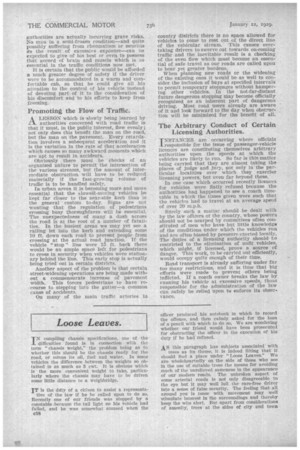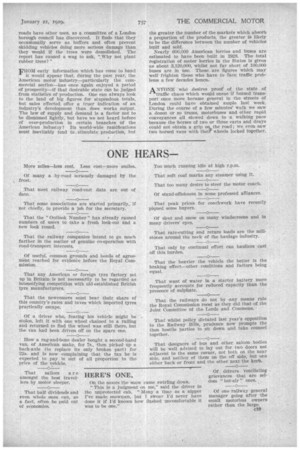Loose Leaves.
Page 2

Page 3

If you've noticed an error in this article please click here to report it so we can fix it.
IN compiling chassis specifications, one of the ' difficulties found is in connection with the term "chassis weight," • the problem being as to whether this should be the chassis ready for the road, or minus its oil, fuel and water. In some vehicles the difference between the weights so obtained is as much as 3 cwt. It is obvious which is the more convenient weight to take, particularly where the chassis may have to be driven some little distance to a weighbridge.
IT is the ddty of a citizen to assist a representa tive of the law if he be called upon to do so. Recently one of our friends was stopped by a constable .because tile tail light on his vehicle had failed, and he was somewhat amused when the officer produced his notebook in which to record the offence, and then calmly asked for the loan of a pencil with which to do so. We are wondering whether our friend would have been prosecuted for obstructing the officer in the execution of his duty if he had'refused.
AS this paragraph has subjects associated with
trees as its theme, it is indeed fitting that it should find a place under "Loose Leaves." We are wholeheartedly on the side of these who see in the use of suitable trees the means for avoiding much of the unrelieved sameness in the appearance of our modern roads. The unbroken aspect of some arterial roads is not only disagreeable to the eye but it may well hill the care-free driver into a sense of false security. The feeling that all around you is tense with movement • may well stimulate interest in the surroundings and thereby keep the wits alert. But apart from considerations of amenity, trees at the sides of city and town
roads have other uses, as a committee of a London borough council has discovered. It finds that they occasionally serve as buffers and often prevent skidding vehicles doing more serious damage than they would if the trees were demolished. The report has caused a wag to ask, "Why not plant rubber trees?"
FROM early information which has come to hand it would appear that, during the past year, the American motor industry—particularly the commercial section—has once again enjoyed a period of prosperity—if that desirable state can be judged from statistics of production. One can always look to the land of big figures for stupendouS totals, but sales effectedoffer a truer indication of an industry's development than does works output. The law of supply and demand is a factor not to be dismissed lightly, but have we not heard before of over-production in certain branches of the American industy? Its world-wide ramifications must inevitably tend to. stimulate, production, but the greater the number of the markets which absorb a proportion of the products, the greater is likely to be the difference between the number of vehicles built and sold.
Nearly 600,000 American lorries and buses are estimated to have been built in 1928. The total registration of motor lorries in the States is given as about 3,120,000, whilst not far short of 100,000 buses are in use. These. are figures which may well' frighten those who have to face traffic problems a few decades hence.
ANYONE who desires proofs of the state of
traffic chaos which would ensue if horsed transport once more became general in the streets of London could have obtained ample last week. During the course of a few minutes' walk we saw a dozen or so trams, motorbuses and other rapid conveyances all slowed down to a walking pace because the 'horses of two or three carts and drays could not obtain a grip oq..the road ; we even saw two horsed vans with their wheels locked together.


































